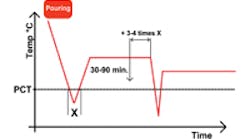Understanding the best way to apply advanced technology coupled with lean manufacturing strategies, to solve problems, reduce cost, save energy, and extend environmental resources, is important to addressing the challenge of global competitiveness. This combination allows sustainable growth and, coupled with the ability to offer product solutions in a timely and efficient manner, creates opportunity for long-term profitability.
Incorporating advanced technology with lean manufacturing strategies often requires changing an older manufacturing process and/or restructuring the manufacturing philosophy, environment, and operation. Aluminum production is a good example of where conversion to new technology, especially with respect to heat treating castings, has been successful in increasing productivity and lowering unit cost.
Foundries producing aluminum castings typically perform several discrete operations: Cooling of castings for handling, mold and core removal, heat treatment, and (optionally) thermal sand reclamation.
In this traditional system the part is cast then allowed to cool and solidify to just above ambient temperature in order for the shakeout (removal) of the outer mold sand and/or knockout of internal cores. If desired, a separate sand reclaimer captures the sand removed from the castings for cleaning and reuse. Then, rthe isers are cut off and the castings are loaded into baskets. The next step in the process is to convey these baskets to batch or continuous furnaces for solution treatment and aging.
Standalone equipment for all operations is typical, which makes the whole process labor intensive. Also, material-handling equipment is necessary to move castings through the various process steps.
To improve efficiencies in foundry heat treating, advanced technology can combine the traditional operations into a single step: avoiding cooling of the castings beyond the solidification temperature, performing core-sand removal, sand reclamation, and heat treatment. Added benefits include more efficient energy recovery and reuse of thermal energy, better part-to-part consistency, less scrap and fewer defects, and producing parts with improved mechanical and metallurgical properties. This type of process meets the criteria of lean manufacturing by using less machinery, minimizing energy usage, reducing work-in-process inventory, utilizing less floor space, lowering emissions, and reducing manual labor. Thus, the system’s efficiencies are greater than the sum of its parts.
Today modern heat-treatment systems, which incorporate lean manufacturing strategies, offer considerable cost savings over traditional manufacturing by requiring less manpower and freeing up personnel to be trained for use in other areas. Product transport is dramatically reduced and automation, simplified material handling, and advanced controls give operators and their supervisors total system control, real-time process monitoring, and historical data acquisition.
CleanCast, an advanced heat-treatment solution, encompasses these lean manufacturing strategies and allows aluminum foundries to improve their overall efficiency at heat treating products like engine blocks and cylinder heads. Higher productivity is achieved by automatically loading castings, complete with cores or sand molds, directly into the system immediately after pouring and discharging a finished product.
CleanCast is based on the patented “process critical temperature,” or PCT, principle, which involves taking the casting package directly from mold filling, while still hot, bypassing knockout, and placing it directly into a 3-in-1 furnace (sand removal, heat treatment, and sand reclamation in one unit.) Robots move castings directly to and from the furnace, quench and age system, and can eliminate baskets and trays.
The PCT principle is based on removing the part at a temperature just before the alloying elements begin to diffuse out of solid solution, that is, shortly after solidification begins. It has been found that for every minute the casting cools below the PCT, an additional 3 to 5 minutes of soak may be required at solution treating temperature.
Once the casting package is in the furnace, high-pressure airflow through impingement nozzles allows de-coring of the castings, thereby decreasing process time for the casting by at least 50% of what’s conventionally required. This entire process creates an environment where less energy and time are required to heat the casting to achieve optimal properties.
Careful analysis of airflow patterns has optimized the patented CEC pulse wave technology, allowing efficient use of radial fans for air recirculation combined with closely positioned air nozzles to impinge directly onto the castings. In this way hot, high-velocity turbulent air removes sand without knockout damage.
System recycling is achieved by purifying removed casting sand with heat and fluidizing air. Up to 60% energy savings are not uncommon, and more than 40% of the used energies are recycled. Binder agents and residue are burned away and effluent pollution is avoided. Typical recycling efficiency is 95%, returning sand for direct reuse to make more molds and cores.
This new heat-treating format uses low volumes of high-pressure heated air to rapidly heat-treat and/or thermally de-core castings. This concept includes three main features:
- Closely positioned air nozzles to impinge the parts.
- Handling parts directly to and from the furnace system, using robotics and eliminating baskets and trays.
- Using shorter-cycle heat treatment to obtain similar properties compared to current longer cycle processes.
These features promote lower equipment capital cost, cellular process arrangements, lower operating costs, and many process benefits. Some of these benefits include:
- Rapid de-coring capability — Less than one hour required to de-core complex V8 cylinder head test castings, even from a cold condition.
- Heat-treatment process consistency — All castings receive the same air-flow.
- Short-cycle heat treatment capability — Potential for shortcycle heat treating, especially if hot castings are processed directly from a casting cell.
- Flexible plant arrangements — Requires less floor space, and a cellular heat-treatment process can receive parts directly from a manufacturing cell.
- Promotes lean, smaller-scale equipment.
- Reduces in-process inventories.
- Allows smaller quench equipment, flexible and programmable quench process, faster time from furnace to submersion in quench, and less retained sand entering the quench.
| Paul M. Crafton is president of Consolidated Engineering Co., a designer/builder of heat-processing systems for metalcasters and other manufacturers. Visit www.cec-intl.com. |










